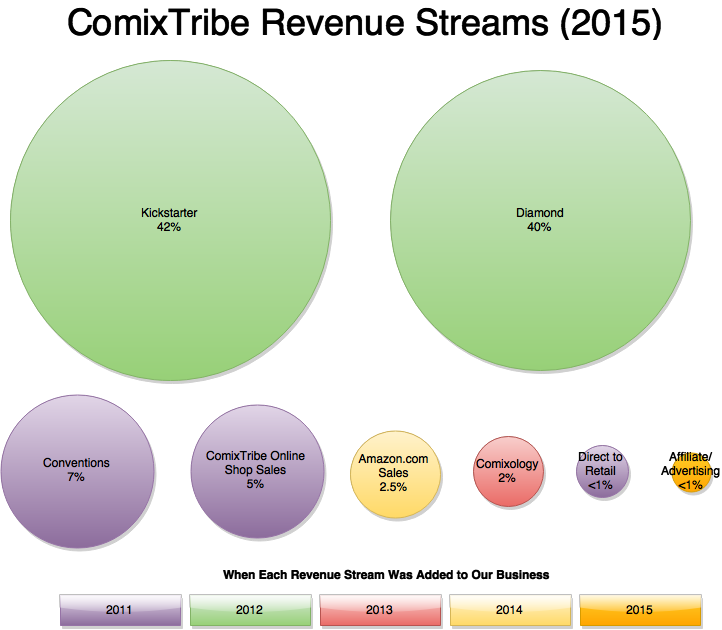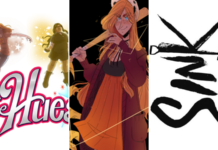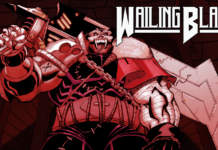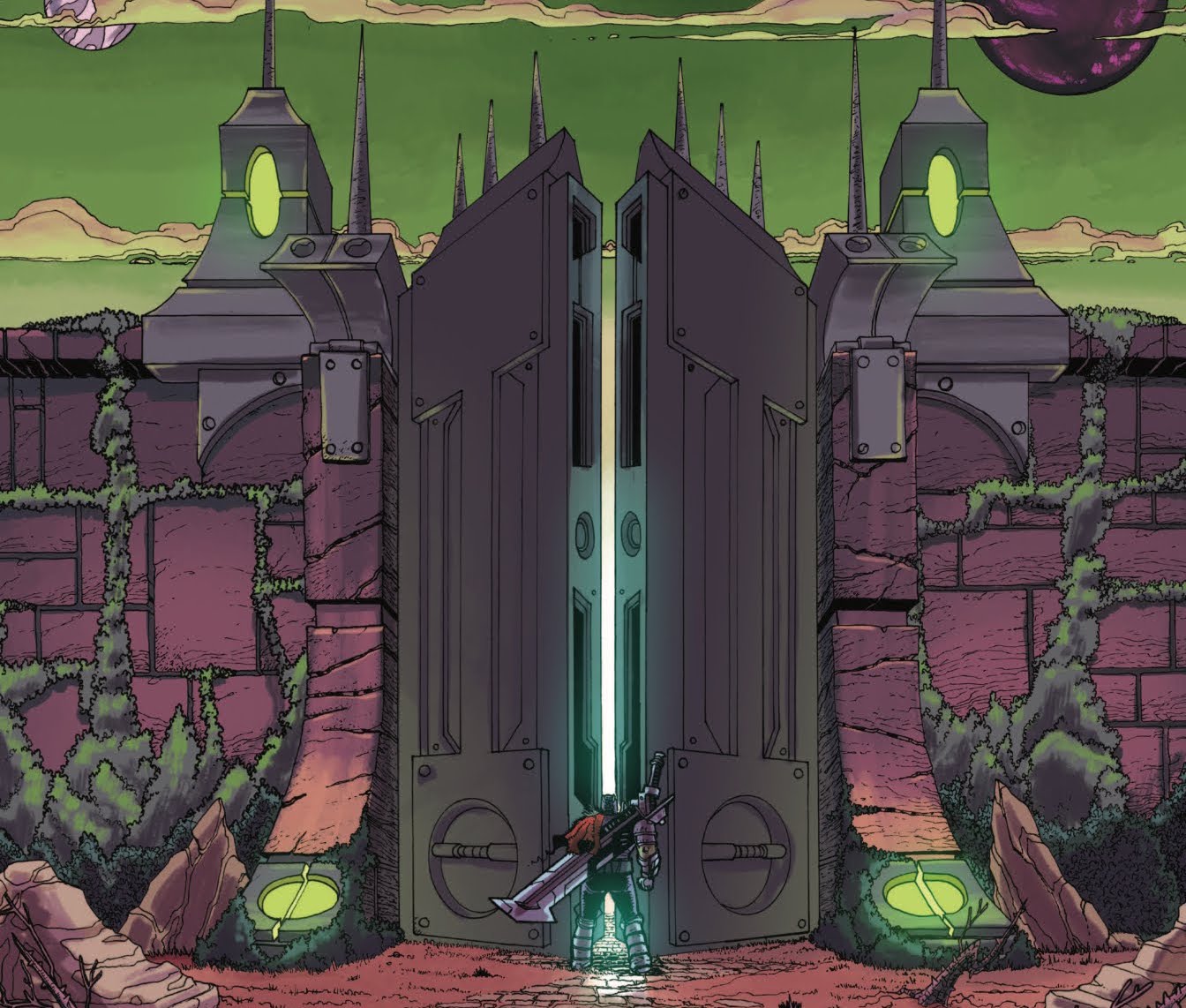Independent publisher ComixTribe has been steadily growing their presence in the direct market, on Kickstarter and especially on the web. ComixTribe.com is a site that’s used not just to promote their products but also to give advice to inspiring and up-and-coming creators. I spoke to Tyler James, the publisher of ComixTribe, about building a reputation in the industry, getting sales and the publisher’s latest Kickstarter campaign for graphic novel The Standard.
How’s the experience been so far Kickstarting The Standard?
The Standard Ultimate Collection Kickstarter is going great!
It’s a tremendous feeling to launch a Kickstarter, send an email, and then 36 hours later, get the printing for an expensive hardcover fully funded… and to do so without any major media coverage or heavy advertising.
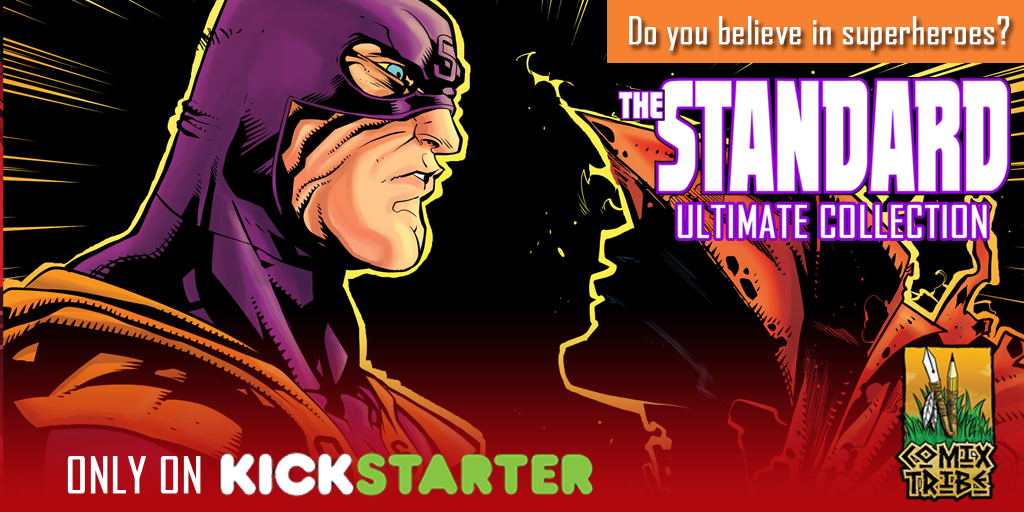
That’s a testament to what ComixTribe has been building over the past four years and where we’re headed. And it’s validation for the extraordinary work of writer John Lees, artist Jonathan Rector, and the rest of THE STANDARD team.
This is not my first Kickstarter rodeo, rather it’s the sixth Kickstarter campaign I’ve actively managed. While the platform continues to change and evolve and add new features and wrinkles, the core of what works and what doesn’t hasn’t changed since our first successful campaign in 2012.
I hear a lot of creators talk about how stressful and nerve-wracking Kickstarters are… and they certainly can be. But I prefer to look at them like a month-long online comic book convention and an opportunity to build a deeper relationships with new and long-time fans. When you frame it like that, the stress melts away and you can have fun with it.
The Standard bears, at least on a surface level, a lot of resemblance to Mark Waid’s Thrillbent comic Insufferable. Was that a concern as you plunged into this Kickstarter campaign?
No disrespect to Mr. Waid, who is one of my favorite writers in all of comics, but when John and Jon first started working on THE STANDARD, he still had his comic book collection! So, any resemblance to Insufferable can be chalked up to coincidence and pulling from the same ideaspace that lifelong superhero fans such as Mark and John will draw on.
The fact that his has been a project long in the making is one of the things that’s so rewarding about this process. While some people (Lees included) were shocked at how fast we were able to get THE STANDARD funded, that 36 hours was really six long years in the making.
Marvel and DC, with their double shipping and weekly series, and the direct market in general, which is built on a monthly release schedule, shape the expectations of readers to think that comics take only a few weeks to make.
And while that may be true for well-compensated professionals working for fully-staffed companies that have been around for seventy years, it’s just not feasible in the indie world.
THE STANDARD was John Lees’ very first comic book… he was literally learning how to write comics as he wrote the series.
As John says in his Kickstarter video, when he first got started on this project, he wasn’t thinking about whether he had a marketable high concept, or whether it was going to sell, or whether there were other books out there like it. At that time, he didn’t know enough about the industry to even think if he should be thinking about that stuff!
Rather, John was thinking that this might very well be the only comic he’d ever make… so why not tell the one story he wanted to tell more than anything else in the world? And why not fill it up with everything he loves about comics – heroism, horror, mystery, romance, heartbreak, innocence lost, and yes, just the right amount of superhero cheese.
Josh Fialkov (The Bunker, Echoes) was gracious enough to write the foreword for AND THEN EMILY WAS GONE, John’s break out horror series from last year. In it, he talked (lovingly) about picking up EMILY #1 and “wanting to punch John in the face” for seemingly coming out of nowhere being so damn good.
What’s great about John’s work and THE STANDARD in particular is that it’s really not trading on a super original, ironic, hip high-concept. There have been plenty of meta superhero deconstruction tales before THE STANDARD and there will be many more to come. You mentioned Insufferable, but I’d actually point to Waid’s Kingdom Come as being a little closer thematically to THE STANDARD.
But it’s not about theme or high-concept. To paraphrase True Detective, “It’s all one story, man. Light and Dark.” What’s brilliant about THE STANDARD is its execution. There’s craft and love for the medium of comics gushing out of every page.
John is going to need a bodyguard when Fialkov realizes this was the first comic John ever wrote!
So, no, to your question. We had a few concerns about launching the Kickstarter, but none of them were about the content itself. This series is rock solid.
My main concern was juggling both the Kickstarter and also at the same time promoting the direct market launch of OXYMORON: The Loveliest Nightmare, our next series launching in August.
I don’t want to ask too many questions about crowdfunding, because you cover the subject so well on ComixTribe.com, but I have to ask a couple. One is: what’s a Kickstarter that impressed you recently, and how did it impress you?
That’s a great question, and I’m always trying to study successful campaigns so I can later model things they do well on the ones I run.
Last month’s Archie Kickstarter campaign was a big story, and many people looked at that campaign scoffing at the lofty sum of $350,000 they were trying to raise for new projects as way too much money and a ridiculous, some might say “greedy”, goal.
Meanwhile, at the same time on Kickstarter, Tim Buckley “quietly” blew past the $350K mark for a reprint of his webcomic CTRL+ALT+DEL in just a few days, later going on to raise more than $665K.
So what continues to impress me about Kickstarter is that, of all platforms available to creators – the direct market, Comixology, Amazon, conventions — Kickstarter is easily the most level playing field.
Individual creators can be more successful than 70 year old publishers on Kickstarter.
While the big numbers of some of these crazy campaigns do catch my eye, the thing I love most about the platform and what impresses me most are the guys and girls going out there and launching their first campaign and succeeding.
Guys like Bill Walko who now gets to make a quality trade collection of his great webcomic Hero Business, or Kristi McDowell whose very first comic Gamer Girl & Vixen got funded.
The numbers don’t matter. I guarantee you, Tim Buckley was no more excited (and perhaps less so) by his $666K than Kristi was about her $7K.
So, yeah, I’m impressed by people who do their homework, run great campaigns, and then fulfill them.
As a side note, the most impressive Kickstarter I’ve ever backed was John August’s Writer Emergency Pack Kickstarter… because of its massive success and because he had his act together, John was able to get rewards out to backers a few weeks after the campaign ended, months earlier than promised. THAT was impressive, and one of the biggest tips I have for creators going to Kickstarter is under promise and over deliver.
What kinds of new lessons are you still learning with each crowdfunding campaign?
So much! The platform is ever evolving. Back in 2012, not only did you have to sell your product, but you had to sell the concept of the platform of Kickstarter itself, and educate potential backers on how it all works. It’s nice not to have to do so much of that anymore, as Kickstarter has slipped more into the mainstream consciousness.
But there are still things I’m learning and working on. “Cracking the code” of the “Kickstarter Deadzone”… that period in the middle of a campaign where pledges and momentum stalls after a big open and before a huge close… that’s something I’m still working on.
Another thing I’m excited about is a new podcast I’ll be debuting next month called ComixLaunch: Crowdfunding Your Comics and Graphic Novels on Kickstarter…and Beyond! I get asked about Kickstarter more than just about anything else, and the articles on Kickstarter are the most read things on ComixTribe.com. So, I’m hoping to dive deeper with a weekly podcast laser focused on this stuff, and hopefully provide a lot of value.
Right now, more than half of all comic book Kickstarter projects fail. I know how much ink, sweat, and tears goes into creating comics and then running a campaign, so those stats are gutting to me.
But I’m very optimistic that ComixLaunch can help improve those numbers. I’ve had dozens of creators personally thank me for the Kickstarter resources I’ve posted on ComixTribe.com, and I’ll be able to go even more in-depth on the pod. Also worth noting, backers of THE STANDARD Kickstarter will be treated to an advanced listen of the first episode of the podcast.
On a practical level, is the purpose of the ComixTribe website, which features as much new content as most comics news websites, primarily to drive sales of your comics?
One of my favorite quotes is by Zig Zigler, who famously said, “You can have everything in life you want, if you will just help enough other people get what they want.” Success in business (and life) is directly correlated to the amount of value you bring to the world. So I get up every day trying to think about how I can best serve the comics community. The natural by-product of that is growth for ComixTribe. It is the epitome of a win win.
Now, when Steve Forbes (affable curmudgeon and ComixTribe Editor-In-Chief) and I first started ComixTribe on 1-1-2011, we didn’t have any comics to sell! We were both writing content for other people’s sites and decided to join forces and launch our own. We both have the heart (and in my case, the background and expensive degrees) of a teacher, and really do love helping other creators make better comics.
In fact, THE STANDARD is a true ComixTribe success story, as it was Steven Forbes who helped John Lees shape his rough concept into the polished gem it is today. Let that be a lesson to all you new writers out there… if you want to increase the odds that your first comic book project is publishable, HIRE AN EDITOR!
After you figure out the basics of this comics game, every creator and every small publisher should devote considerable effort into picking their edges. By that I mean figuring out what makes them unique? Why should anyone give a damn? What do they want to be known for?
Opening the ComixTribe kimono, so to speak, and being transparent about our successes, lessons learned, struggles and triumphs in the form of articles on ComixTribe.com has definitely helped distinguish us from other small comics publishers out there.
At the same time, as we’ve grown, and really expanded our titles, it’s been tough to balance serving both creators who are interested in our advice and readers who love our books. While there is certainly some overlap between the two audiences, and our peers are also some of our biggest supporters, it is a challenge to be viewed as both an imprint and a web resource.
But my purpose in life is to educate and to entertain, so I’ll likely always have a toe in both pools.
Have you considered adding revenue streams like advertising or sponsorships?
Adding revenue streams has been a core focus of ComixTribe over the past few years, and is certainly one of my primary focuses this year.
Here’s a little infographic showing where the ComixTribe revenue comes from, and when we’ve added those streams to our business, and relatively how important those streams are to our business right now.
If we had to rely on any one of those streams, we’d be dead in the water. The magic is in diversification.
Over the past couple months, I’ve been making a concerted effort to look for new partnerships, whether that be advertising, sponsorships, or affiliates that can bring value to our readers.
I spend at least ten minutes every day thinking of at least ten new ideas… ideas on everything from ways to sell more comics, to creators I want to work with, to things I love about my wife, to ideas for new lists of ideas… the list itself isn’t so important. The important thing is exorcising that idea muscle.
That practice is training me to see connections and solve problems more instinctively than before… granted most of the ideas I come up with are ridiculous and wrong for me. But it only takes a couple gems to make a significant difference in life and business.
So, yes, we’re adding new revenue streams and always looking for new potential partners, and you’ll see some of those come to life in the near future.
What are your other priorities?
Right now, ComixTribe’s top focus is readership growth.
That means increasing our direct connection with readers and the best way to do that is to get our books into readers’ hands.
Free Comic Book Day 2015 was a huge win for us. We increased our reader email subscribers by about 50% thanks to the 50,000 copies of AND THEN EMILY WAS GONE #0 that were given out.
And everyone who subscribes to our list gets hooked up with the first issue of our five top titles, so that’s really our single best play to turn strangers into raving fans.
But readers aren’t enough… increasing the number of retailers carrying our books is also one of my top priorities.

I’ve set a goal to double our direct market sales for our next series OXYMORON: The Loveliest Nightmare from our previous best seller. And I’ve already committed to a print run that’s double what we printed for EMILY #1, even prior to getting our Diamond orders… so the boats have been burned, there’s no turning back, now!
Most of the comics put out by ComixTribe are about superheroes. Do you think that will change given that And Then Emily Was Gone, arguably Comixtribe’s biggest success, wasn’t?
It’s true that the first four titles we introduced to the market were all superhero books, or at least twists on the superhero genre. Joe Mulvey’s SCAM for example, is a capes books where the capes were replaced with conman capers.
But I think it’s important not to confuse where ComixTribe chose to start, with where we’re going. Let’s remember that Image Comics, widely regarded as one of the most diverse and respected publishers today, started exclusively with superhero books.
And there’s a reason for that, right? Most creators were initially drawn to the medium by superheroes. Tracing cool panels featuring Spider-man at eight years old was my gateway into drawing my own comics.
When I first approached artist Cesar Feliciano about collaborating, I pitched him five different concepts… but he was most interested in doing THE RED TEN, a team superhero book, something he’d always dreamed of doing. (And that was the one I was hoping he’d dig as well.)
One of the great things about ComixTribe is that all the books we publish are, first and foremost, books we ourselves want to read.
And at 36 years old, I’m still not ashamed to say I love a good superhero yarn.
That said, I haven’t greenlit a new superhero project under the ComixTribe banner in a couple years now, and would have to have my socks blown off by a pitch to do so.
The new OXYMORON series actually takes the character who debuted in THE RED TEN, and strips away any and all superhero trappings. The high concept for the series that’s been generating a lot of buzz is asking readers to “Imagine The Joker came to a Gotham WITHOUT Batman.” So, this series is more police procedural and cerebral horror thriller than anything else.

Likewise, we’ve got EXIT GENERATION from Sam Read and Caio Oliveira, a previously self-published gem from the UK, which is an all-ages sci-fi book with a punk rock ethos coming out later this fall.

Joe Mulvey’s next series, CounterTERROR, which we are soft-launching at the 2015 Boston Comic Con, is a political thriller mashed up with a paranormal action popcorn flick. Think “What if Jack Bauer was a Ghostbuster?”

And I fully expect Ryan K Lindsay (Negative Space, Headspace) and Sami Kivelä’s unannounced new surf noir book to raise the bar for ComixTribe again in 2016.
We also have a couple new anthology projects I’m very excited about coming up that take us into new exciting new genres.
In short, we unabashedly love superhero comics at ComixTribe, but we’re about a lot more than spandex.
Do you have aspirations to work with publishers other than ComixTribe?
I think most people who make comics would be lying if they told you they didn’t want the opportunity to work on the icons and make a contribution to the great comic book universes that they grew up loving.
Every creator has a Spidey story, or a Batman story, or I don’t know, a Howard the Duck tale, they’d love the opportunity to tell.
For me, it was Image Comics that really ignited my passion for creating comics, so having a book with an Image “i” on the cover has long been a goal for me. (You can listen to me fanboy gush over Erik Larsen when he was a guest on the Final Issue Podcast.)
So, sure, if given the right opportunity, I’d jump at the chance to work with legendary publishers.
But that’s not the endgame for me.
It’s an interesting time in comics. Marvel and DC, they have great talent working for them, sure. But the absolute best talent in comics are no longer found there… or at least no longer found EXCLUSIVELY there. Millar, BKV, Staples, Kirkman, Adlard, Ottley, Brubaker, Phillips… the cream of the crop all realized that the ceiling at the Big Two was far too low for their talents.
And that’s a great thing, I think, for the industry, and for comics in general.
How do you plan on continuing to grow ComixTribe?
One reader, shop, and creator at a time.
I sold my first comic at age 14 out of my backpack in school. (9 copies sold at a $1 a piece!)
Since then, ComixTribe has managed to get more than 200,000 copies of books printed and out there into the world. (Sorry, trees!) And as crazy as that number is to me, it still means we’re just a guppy in the comics industry ocean.
Still, ComixTribe has doubled its revenue every year for the past four years.
We are poised to double again this year, as long as we continue to execute.
It’s been a long, hard road to get here… a barely profitable, low six-figure business, that reinvests 100% of profits back into itself.
But it’s still early days for us. We’re maybe on mile two of our comics marathon.
And I see the roadmap…
I know exactly what we need to do to take ComixTribe to a somewhat profitable seven-figure business, and beyond.
(This is the part where I knock on wood… and remind myself of the danger of “best laid plans” and that I could be hit by a bus or a falling anvil at any moment.)
But it’s not rocket science. And it’s not all that complicated…
The closest thing I have to a success formula goes something like this: P + A + I + N + T = S
Passion + Action + Integrity + a Network + Talent = Success.
I firmly believe that if you have all of those ingredients, the only variable in your success is TIME.
Because the truth is, those ingredients, even when found in copious amounts, do take a while to cook.
And if you’re not currently as successful as you want to be… you may be lacking one or more of those elements, and that is where you should be putting your focus.
We need a new name for it because “The Golden Age” is taken… but these are the halcyon days for being a comic book creator.
Over the next few years, we’re going to get a million ComixTribe comics into readers’ hands.
We’re going to continue to add tremendous value to the comic creator community, through continuing the awesome free content on ComixTribe.com, and through podcasts and other educational products and ventures.
And we’re going to work directly with at least one hundred creators, and help a bunch of them break into the direct market for the first time.
How is ComixTribe going to do all this?
Well, I’ve got a plan, but I’m nimble, and will be figuring it out as I go along.
And you can be sure I’ll be doing it transparently and in plain sight, as I’ve done from ComixTribe’s inception…
So, just watch.
MATT CHATS is a weekly interview series with a person of prominence and/or value in the comic book industry. Find its author, Matt O’Keefe, on Twitter and Tumblr. Email him with questions, comments, complaints and/or suggestions praise at [email protected].


